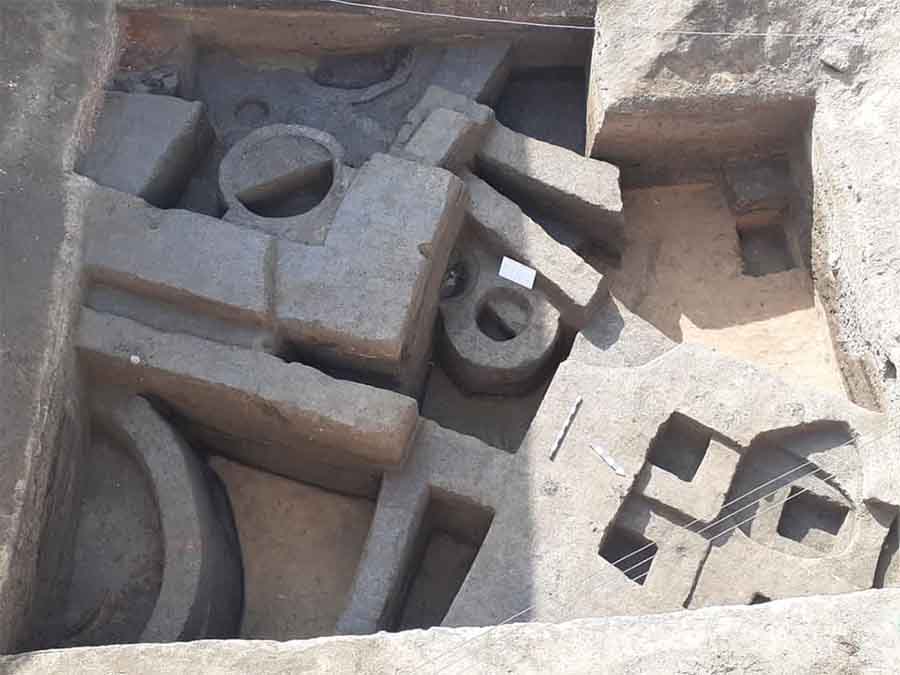Archaeologists working in Egypt’s Beheira governate have made a significant discovery—a well-preserved pottery workshop dating back to the Graeco-Roman period. This find provides a unique glimpse into the pottery-making techniques and cultural practices of a bygone era. The workshop’s excellent state of preservation allows archaeologists to piece together the entire process of pottery production, from raw clay preparation to the final firing of ceramics.
Location and Historical Context
The workshop was discovered at the Tell Kon Aziza site, near the village of Abu Hummus in northern Egypt. This location is situated about 32 miles (50 kilometers) southeast of Alexandria and 105 miles (169 kilometers) north of Cairo. The site has a long and complex history, with evidence of human settlements dating back to antiquity.
The Graeco-Roman period in Egypt spans from approximately 332 BC, when Alexander the Great invaded and conquered the country, to the late fourth century AD. This period encompasses the Greek Ptolemaic Dynasty’s rule, followed by the Roman Empire’s governance after Augustus Caesar’s victory over Cleopatra VII in 30 BC. The era is known for its blend of Greek, Roman, and Egyptian cultures, creating a unique historical context for the pottery workshop’s discovery.
Discovery and Excavation
The discovery was made by a team of archaeologists led by Dr. Ibrahim Sobhi from Fayoum University. Working under the authority of Egypt’s Ministry of Tourism and Antiquities, the team unearthed the pottery workshop at the Tell Kon Aziza site. The researchers were surprised by the workshop’s remarkable preservation, which allowed them to trace the complete process of pottery production, offering a rare opportunity to understand ancient pottery-making techniques in detail.
The excavation revealed a well-defined layout for the pottery workshop, with distinct areas for each stage of production:
- Mixing Area: This section was used to knead and mix raw clay with other substances to improve its texture and suitability for pottery making.
- Formation Area: Here, the clay was shaped into its desired final form, often using a potter’s wheel.
- Drying Area: After being shaped, the clay was laid out in the sun to dry and remove excess moisture before firing.
- Firing Area: Furnaces in this area were used to fire the clay at high temperatures, converting it into durable ceramic pottery.
Technological Insights from the Workshop
The workshop’s furnaces and kilns were especially noteworthy for their sophisticated design. Built from fired bricks, the furnaces featured powerful updraft kilns surrounded by thick mud bricks to reduce heat pressure during the firing process. The kilns were equipped with gas supply pipes and pressure valve pipes, allowing for precise heat control, indicating a high level of craftsmanship and technological knowledge.
Artifacts and Cultural Influences
In addition to the workshop’s structural elements, the archaeologists uncovered a variety of artifacts that provide insight into the pottery-making process and the broader cultural context. These artifacts included finished ceramic pieces, un-baked molded clay, ancient metal tools for shaping and cutting clay, and the remains of a potter’s wheel. The discovery of the potter’s wheel is significant, as this technology was widely used in Egypt by the mid-third millennium BC and is believed to have originated during Egypt’s Old Kingdom period, also known as the Age of the Pyramids.
The presence of finished pottery and the craftsmanship observed in the workshop suggest a high level of skill among the ancient potters. However, the Ministry of Tourism and Antiquities did not specify whether the pottery showed signs of Greek or Roman influence, which would help narrow down the precise dating of the workshop. Dr. Mustafa Waziri, Secretary General of Egypt’s Higher Archaeology Council, estimated that the workshop dates to between the third century BC and the first century AD, a timeframe covering both Greek and Roman rule during the Graeco-Roman period.
Deeper Discoveries and Ancient Burials
As the excavation progressed, the archaeologists found evidence of even earlier settlements beneath the pottery workshop. This discovery included artifacts and structures from more ancient occupants of the Aziza hills area, indicating a long history of human habitation at the site. Notably, the team found the remains of two individuals in mudbrick burials, suggesting that this site had been used for burial purposes before the pottery workshop was constructed.
Conclusion
The discovery of the preserved ancient pottery workshop in Egypt provides a captivating look into the Graeco-Roman period and the pottery-making practices of the time. The workshop’s detailed layout and the variety of artifacts recovered offer invaluable insights into the craft and technology of ancient Egyptian pottery production. Additionally, the broader context of the site, with its earlier burials and structures, highlights the rich and complex history of this region.
As archaeologists continue their work at the Tell Kon Aziza site, more details may emerge, further illuminating the cultural influences and historical significance of this remarkable discovery. The find is a testament to the skill and ingenuity of ancient Egyptian potters and serves as a valuable contribution to our understanding of Egypt’s rich archaeological heritage.
Other Posts: Ancient Woodworking: A Groundbreaking Discovery at Kalambo Falls RajExplorer

